![]()
![]()
![]()
Use LEFT and RIGHT arrow keys to navigate between flashcards;
Use UP and DOWN arrow keys to flip the card;
H to show hint;
A reads text to speech;
79 Cards in this Set
- Front
- Back
- 3rd side (hint)
|
List 8 Energy Stores: |
Energy is Transferred between Stores 1) Thermal Energy stores 2) Kinetic energy stores 3) Gravitational Potential energy stores 4) Elastic Potential energy stores 5) Chemical energy stores 6) Magnetic energy stores 7) Electrostatic energy stores 8) Nuclear energy stores |
|
|
|
How can Energy be transferred? (4) |
Energy is transferred mechanically (by a force doing work), electrically (work done by moving charges), by heating or by radiation (e.g. light or sound) |
|
|
|
What is a system? |
A system is a single object or a group of objects that you're interested in. When a System Changes, Energy is Transferred |
|
|
|
What is a Closed System? |
Closed Systems are systems where neither matter nor energy can enter or leave. The net change in the total energy of a closed system is always zero. |
|
|
|
What is Work Done? |
Work Done = Energy Transferred
Work is Done when: - A Current Flows - A Force Moves an Object |
|
|
|
Describe all the energy transfers that take place when boiling water in a kettle |
Energy is transferred electrically to the thermal energy store of the kettle's heating element, which transfers energy by heating to the water's thermal energy store. |
|
|
|
Describe the energy transfers that take place by throwing a ball upwards |
The initial force exerted by a person to throw a ball upwards does work. It causes an energy transfer from the chemical energy store of the person's arm to the kinetic energy store of the ball and arm. |
|
|
|
Describe the energy transfers that take place when a Ball is dropped from a height |
A ball dropped from a height is accelerated by gravity. The gravitational force does work. It causes energy to be transferred from the ball's gravitational potential energy store to its kinetic energy store. |
|
|
|
Describe the energy transfers that take place when a car's brakes are turned on |
A Car Moving has a Kinetic Energy Store. When the Driver presses the Brakes, the Brakes press against the Wheel. This creates Friction. The Kinetic energy store of the Car is Transferred to the Thermal energy store of the Brakes. The Temperature of the Brakes Increases and the Car Slows Down and Stops. |

|
|
|
Describe the energy transfers that take place when a car collides with a stationary object |
In a collision between a car and a stationary object, the normal contact force between the car and the object does work. It causes energy to be transferred from the car's kinetic energy store to other energy stores e.g. the elastic potential and thermal energy stores of the object and the car body. Some energy might also be transferred away by sound waves. |
|
|
|
Describe the energy transfers that take place when the wind causes a windmill to spin |
Energy is transferred mechanically from the kinetic energy store of the wind to the kinetic energy store of the windmill. |
|
|
|
What is the equation for Kinetic Energy? |
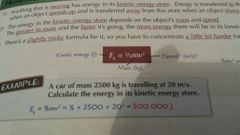
|
|
|
|
What is the equation of GPE? |
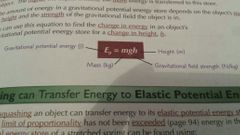
|
|
|
|
Describe how falling objects transfer energy |
When something falls, energy from its gravitational potential energy store is transferred to its kinetic energy store. For a falling object when there's no air resistance: Energy lost from the GPE store = Energy gained in KE store |
|
|
|
How would air resistance affect a falling object's energy transfer? |
In real life, air resistance acts against all falling objects - it causes some energy to be transferred to other energy stores, e.g. the thermal energy stores of the object and surroundings. |
|
|
|
Link Stretching/Squashing to an Energy store |
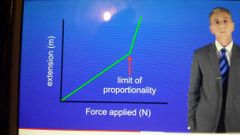
Stretching or squashing an object can transfer energy to its elastic potential energy store. So long as the limit of proportionality has not been exceeded.
EPE = 0.5 × K × (E)^2
|
|
|
|
What is the equation of Elastic Potential Energy? |

|
|
|
|
What is Specific Heat Capacity? |
Specific Heat Capacity is the amount of energy needed to raise the temperature of 1kg of a substance by 1°C. |
|
|
|
What is the equation of Specific Heat Capacity? |
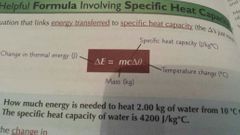
|
|
|
|
What is the Conservation of Energy Principle? |
Energy can be transferred usefully, stored or dissipated (wasted), but can never be created or destroyed. |
|
|
|
How might energy be dissipated? |
Dissipated energy = Energy that has not been Stored Usefully. E.g. Heat given out
Dissipated Energy is sometimes called Wasted Energy |
|
|
|
Describe the useful and Dissipated energy transfers in phones |
A mobile phone is a system. When you use the phone, energy is usefully transferred from the chemical energy store of the battery in the phone. But some of this energy is Dissipated in this transfer to the thermal energy store of the phone. |
|
|
|
Describe the energy transfers of closed systems: a cold spoon dropped into an insulated flask of hot soup |
A cold spoon is dropped into an insulated flask of hot soup, which is then sealed. You can assume that the flask is a perfect thermal insulator so the spoon and the soup form a closed system. Energy is transferred from the thermal energy store of the soup to the useless thermal energy store of the spoon (causing the soup to cool down slightly). Energy transfers have occurred within the system, but no energy has left the system - so the net change in energy is zero. |
|
|
|
What is an Insulator? |
Insulators are materials/objects that do not easily allow heat, electricity, light or sound to pass through it. |
|
|
|
What is a Conductor? |
A Conductor is an object/material that allows heat and electricity to pass through it. |
|
|
|
Define Power |
Power = Rate of Energy Transfer Power = Rate of Doing Work |
|
|
|
What is Power measured in? |
Power is measured in Watts. One Watt = 1 Joule of Energy Transferred per Second |
|
|
|
Write 2 equations for Calculating Power (Rate of Energy/Work) |
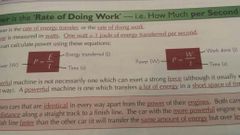
|
|
|
|
Why is a powerful machine not necessarily one that exerts a strong force? |
A powerful machine is not necessarily one which can exert a strong force. A powerful machine is one which transfers a lot of energy in a short space of time. E.g. A faster Motor would be more powerful than a slow motor. |
|
|
|
Describe Thermal Conductivity |
The Higher the Thermal Conductivity of a Material, the Higher the Rate of Energy Transfer by Conduction Across that Material.
|
|
|
|
Give 2 examples of how you can Reduce unwanted Energy Transfers |
We can Reduce Unwanted Energy Transfers by Reducing Friction:
Lubrication e.g. Oil
Insulation |
|
|
|
What Unwanted Energy Transfer does Insulation Reduce? |
Insulation Reduces the Rate of Energy Transfer by Heating |
|
|
|
Describe How you Reduce Thermal Energy Transfer from a House |
- Construct the Building Using Materials with a Low Thermal Conductivity: Cavity Walls, Double Glazed Windows, Loft Insulation.
- Build the House with Thick Walls as this also Reduces the Rate of Thermal Energy Transfer.
|
|
|
|
Give some examples of Thermal Insulation |
1) Cavity Wall Insulation, where the Cavity wall Air Gap between 2 Walls is Filled with Insulating Material which has a Very Low Thermal Conductivity.
2) Double Glazed Windows have a Low Thermal Conductivity so Less Energy can Pass through Windows and Leave the House Interior.
Single Glazed Windows have a High Thermal Conductivity so a lot of Thermal energy can escape.
3) Loft Insulation Reduces the amount of Thermal Energy that escapes through the Roof of a House as it has a Low Thermal Conductivity. |
|
|
|
How can you improve the efficiency of Energy Transfers? |
You can improve the efficiency of Energy Transfers by Insulating objects, Lubricating them or making them more Streamlined Less Energy Wasted = More Efficient |
|
|
|
What are the Equations (2) for Efficiency? |

Efficiency can't be greater than 100% |
|
|
|
Describe How Using a Kettle is More Efficient than Using a Pan to Heat Water |
Because a Pan is made of Metal which is a Good Conductor of Heat so Thermal Energy will Pass through the Lid and Side of the Pan and into the Air. A Kettle is Made of Plastic so Less Thermal Energy can Pass through the Walls and the Lid and into the Air. |
|
|
|
What are Non-Renewable Energy Resources |
Non-Renewable Energy Resources will Run Out One Day |
|
|
|
Give examples of Non-Renewable Energy Resources |
Non-Renewable Energy Resources are Fossil Fuels (coal, oil, natural gas) and Nuclear Fuel (uranium and plutonium) |
|
|
|
What are the Uses of Energy Resources? |
Uses of Energy: - Transport - Generating Electricity - Heating |
|
|
|
What are the 3 Main Fossil Fuels? |
The 3 Main Fossil Fuels are: - Coal - Oil (fuel cars) - (Natural) Gas (heat homes) |
|
|
|
Describe Non-Renewable Energy Resources |
- They will all run out one day.
- They all do damage to the environment.
- But they provide most of our energy |
|
|
|
What are Renewable energy Resources? |
Renewable Energy Resources Will Never Run Out |
|
|
|
Give Examples of Renewable energy Resources |
Renewable energy Resources are: - The Sun (Solar) - Wind - Water Waves - Hydro-Electricity - Bio-Fuel - Tides - Geothermal |
|
|
|
Describe Renewable energy Resources |
These will never run out - the energy can be 'renewed' as it is used. Most of them do less damage to the environment than Non-Renewable Energy Resources. They don't Provide much energy Some of them are Unreliable because they depend on the weather. |
|
|
|
Describe the Advantages and Disadvantages of Using Fossil Fuels |
Fossil Fuels : Advantages - They are Reliable. - They Release a Great Deal of Energy - Fossil Fuels are Abundant + Relatively Cheap - Fossil Fuels are Extremely Versatile (they have many Uses) Fossil Fuels : Disadvantages - Burning Fossil fuels Releases a Huge Amount of Carbon Dioxide. - Fossil Fuels are Non-Renewable. They will Eventually Run Out. - Burning Fossil Fuels Releases Other Pollutants. E.g. Burning Diesel Releases Carbon Particles + Nitrogen Oxide which is very harmful to health. E.g. Burning Coal Produces Sulfur Dioxide which leads to Acid Rain. Damage buildings + trees |
|
|
|
Describe the Advantages and Disadvantages of Using Nuclear Power |
Nuclear Power is Non-Renewable. Nuclear Power Plants run on the Elements: Uranium and Plutonium
Nuclear Power : Advantages
- Nuclear power Plants Don't Release Carbon Dioxide. They don't Contribute to Climate Change.
- Nuclear power is Extremely Reliable.
Nuclear Power : Disadvantages
- Nuclear Power Plants Contain Highly Dangerous Radioactive Materials. If there's an accident these material could be Released into the Environment.
- Decommissioning a Power Plant takes Many Years and is Very Expensive.
- They also Generate Large Amounts of Radioactive Waste. This needs to be Stored for Thousands of Years before its safe.
|
|
|
|
Describe how Renewable energy Resources are used for Heating homes |
A geothermal heat pump uses Geothermal energy Resources to heat buildings.
Solar water heaters work by using the sun to heat water which is then pumped into radiators in the building.
Burning Bio-Fuel or using Electricity generated from renewable resources can also be used for heating. |
|
|
|
What does Wind Power involve? |
Wind Power involves putting lots of wind turbines up in exposed places like on moors or round coasts. |
|
|
|
What are the advantages of using Wind Power? |
There's no pollution The initial costs are quite high, but there are no fuel costs and minimal running costs. There's no permanent damage to the landscape - if you remove the turbines, you remove the noise and the view returns to normal. |
|
|
|
What are the Disadvantages of Wind Power? |
They spoil the view.
They can be very noisy, which can be annoying for people living nearby.
They are Unreliable when the wind stops or if the wind is too strong.
It's also impossible to increase supply when there's extra demand.
Initial costs are quite high
They don't generate as much electricity as Non-Renewables.
|
|
|
|
How does Solar Power in Solar Cells work? |
Solar Cells generate electric currents directly from sunlight. |
|
|
|
What are Solar Cells best used for? |
Solar Cells are often the best source of energy to charge batteries in calculators and watches which don't use much electricity. |
|
|
|
Where is Solar Power mostly used? |
Solar Power is often used in remote places where there's not much choice and to power electric road signs and satellites. |
|
|
|
What are the Advantages of Solar Power? |
There's no pollution. In sunny countries solar power is a very reliable source of energy - but only in the daytime. Initial Costs are high but after that the energy is free and running costs almost nill. |
|
|
|
What are the Disadvantages of Solar Power? |
Like wind, you can't increase the power output when there is extra demand. Solar cells are usually used to generate electricity on a relatively small scale. Only reliable when it's sunny in the daytime. |
|
|
|
What are the Advantages of Geothermal Power? |
Geothermal Energy Uses Heat from the Earth to Generate Electricity and Heat Buildings. Geothermal Power is actually brilliant free energy that's reliable and does very little damage to the environment.
|
|
|
|
What are the Disadvantages of Geothermal Power? |
The main disadvantages with Geothermal Power are that there aren't very many suitable locations for power plants, and that the cost of building a power plant is often high compared to the amount of energy it produces. |
|
|
|
Why does Hydro-electric Power have a big impact on the environment? |
There is a big impact on the environment due to the flooding of the valley (rotting vegetation releases methane and Carbon Dioxide) |
|
|
|
What does rotting vegetation release? |
Rotting vegetation releases methane and Carbon Dioxide. |
|
|
|
What are the advantages of Hydroelectric Power? |
- There is no pollution.
- It can provide an immediate response to an increased demand for electricity.
- There's no problem with reliability except in time of drought.
- Initial Costs are high, but there are no fuel costs and minimal running costs.
- It can be a useful way to generate electricity on a small scale in remote areas. |
|
|
|
What are the Disadvantages of Hydroelectric Power? |
- There is a big impact on the environment due to the flooding of the valley and possible loss of habitat for some species. - The reservoirs can also look very unsightly when they dry up. - Initial Costs are high. |
|
|
|
What are the advantages of Wave Power? |
- There is no pollution. - Initial Costs are high, but there are no fuel costs and minimal running costs. - Wave Power can be very useful on small islands. |
|
|
|
What are the Disadvantages of Wave Power? |
- The main problems are disturbing the seabed and the habitats of marine animals, spoiling the view and being a hazard to boats. - They are fairly unreliable, since waves tend to die out when the wind drops. - Initial Costs are High. - Wave Power is never likely to provide energy on a large scale. |
|
|
|
What is Used for Tidal Power? |
Tides are used in lots of ways to generate electricity. The most common method is building a tidal barrage. |
|
|
|
What are the Advantages of Tidal Power/ Tidal Barrages? |
- There is no pollution.
- Tides are pretty reliable in the sense that they happen twice a day without fail, and always near to the predicted height.
- Initial Costs are moderately high, but there are no fuel Costs and minimal running costs.
|
|
|
|
What are the Disadvantages of Tidal Power/ Tidal Barrages? |
- The main problems are preventing free access by boats, spoiling the view and altering the habitat of the wildlife.
- Initial Costs are moderately high.
- Tidal Power can only be used in some of the most suitable estuaries. |
|
|
|
How are Bio-Fuels Supposedly Carbon Neutral? |
Bio-Fuels are supposedly Carbon Neutral as you keep growing plants at the same rate that you're burning things. |
|
|
|
What are the Advantages of Bio-Fuels? |
Biofuels are produced from Plant Materials. Burning Biofuels does not Add Extra Carbon Dioxide to the Atmosphere (Carbon Neutral) Biofuels are Very Useful as they can be Used to Power Vehicles e.g. Cars + Buses. Bio-Fuels are fairly reliable, as crops take a relatively short time to grow and different crops can be grown all year round.
|
|
|
|
What are the Disadvantages of Bio-Fuels? |
- The Cost to refine Biofuels so that they are Suitable to Use is Very High.
- If we Use Land to grow crops for Fuel, that Could Push up the Price of Food.
- In some regions, large areas of forest have been cleared to make room to grow Bio-Fuels, resulting in lots of species losing their natural habitats.
|
|
|
|
Describe how Non-Renewables Create Environmental Problems |
- Coal, Oil and Gas release Carbon Dioxide into the atmosphere when they're burned. All this CO2 adds to the greenhouse effect, and contributes to Global Warming. Burning Coal and Oil also release Sulfur Dioxide, which causes Acid Rain - which can be harmful to trees and soils and can have far - reaching effects in ecosystems.
Coal Mining makes a mess of the landscape. As with many energy resources, the view can be spoilt by fossil fuel power plants. Oil Spillages cause serious environmental problems, affecting sea creatures. Nuclear Power is clean but the nuclear waste is very dangerous and difficult to dispose of. |
|
|
|
Describe the Difference in Electricity use of the UK spanning from the 20th Century to the 21st Century |
Over the 20th Century, the electricity use of the UK hugely increased as the population grew and people began to use electricity for more things. Since the beginning of the 21st Century, electricity use in the UK has been decreasing, as we get better at making appliances more efficient and become more careful with energy use in our homes. |
|
|
|
Where is Most of our Electricity Produced from? |
Most of our Electricity is produced using Fossil fuels (mostly coal and gas) and from Nuclear Power. |
|
|
|
Why is the UK trying to increase the Renewable energy Resources? |
The Fact that Burning Fossil Fuels is very damaging to the environment makes people want to use more Renewable energy Resources that effect the environment less.
People and Governments are also becoming increasingly aware that Non-Renewables will run out one day. Many people think it's better to learn to get by without Non-Renewables before this happens. |
|
|
|
Give Scientific Evidence to why People are Against Switching To Renewable Resources and Why The Use of Renewables is Limited By Reliability, Money and Politics
|
- Building New Renewable Power Plants costs money, so some energy providers are reluctant to do this, especially when fossil fuels are so cost effective. - If New Power Plants are Built, there are Arguments over where to Put Them. E.g. People don't want to live near Wind Farms. - Some Renewable Energy Resources like Wind Power are Unreliable, whilst Others Cannot Increase their Power Output on Demand. - Research on Improving the Reliability and Cost of Renewables Takes Time and Money. It could take Years for Improvements to be made. - Making Personal Changes e.g. Switching cars, installing Solar panels can be Expensive. |
|
|
|
Write a Method on How to Investigate Specific Heat Capacity
Measuring the Specific Heat Capacity of Vegetable Oil
REQUIRED PRACTICAL 1 |
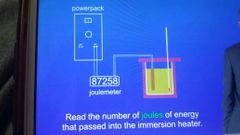
1) Place a Beaker on a Balance and Press Zero. Then Add the Oil/Liquid to the Beaker and Record the Mass of the Oil.
2) Place a Thermometer and an Immersion Heater into the Oil and Record the Starting Temperature of the Oil.
3) Then Wrap the Beaker in Insulating Foam to Reduce Thermal Energy Transfer to the Surroundings.
4) Connect a Joulemeter and PowerPack to the Immersion Heater and Leave for 30 Minutes.
5) Then Read the Total Number of Joules of Energy that Passed into the Immersion Heater. Read the Final Temperature of the Oil.
Then Use This Information to Calculate the Specific Heat Capacity (Rearrange Formula) |
|
|
|
Write a Method on Investigating the Effectiveness of Different Materials as Thermal Insulators REQUIRED PRACTICAL 2 |

1) Place a Small Beaker inside a Big Beaker and Boil Water in a Kettle. Then Transfer 80cm^3 of the Hot Water into the Small Beaker. 2) Then Use a Piece of Cardboard as a Lid for the Large Beaker. The Lid must have a Hole for the Thermometer. 3) Place the Thermometer through the Hole in the Lid. Make sure that the Bulb of the Thermometer is in the Hot Water. 4) Record the Starting Temperature of the Water and Start a Stopwatch. Record the Temperature Every 3 Minutes for 15 Minutes. 5) Then Repeat the Experiment Using the Same Volume of Water but fill in the Gap between the Beakers with a Different Insulating Material each Time (e.g. Bubble wrap, Cotton wool, newspaper). Make sure to Use the same Mass of the Material. 6) Record your Results in a Table and Plot a Graph The Water Will Cool Down Most Slowly with the Most Effective Insulating Material. |
|
|
|
Write a Method to Investigate How the Thickness of a Material Affects the Thermal Insulation
REQUIRED PRACTICAL 2 |
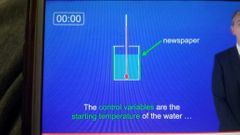
1) Boil Water in a Kettle. Pour 80cm^3 of Hot Water into a Small Beaker.
2) Use Cardboard as a Lid and Leave a Hole for the Thermometer into the Beaker - Make sure that the Bulb is in the Hot Water then Measure the Starting Temperature of the Water. Then Start the Stopwatch.
3) Record the Temperature of the Water Every 3 Minutes for 15 Minutes.
4) Then Repeat the Experiment, but Wrap 2 Layers of Newspaper around the Beaker. Then Repeat the Experiment 2 More Times using 4 Layers and 6 Layers of Newspaper.
Independent Variable = Layers of Newspaper.
Dependent = Temperature
Control = Volume of Water, Starting Temperature of Water.
The More Layers of Newspaper, the Slower the Water Cools Down. This is because More Layers is a More Effective Thermal Insulator than Fewer Layers. |
|
|
|
What are the Sources of Inaccuracy in Calculating the Specific Heat Capacity in Required Practical 1? |
1) Thermal Energy Passing Out of the Beaker into the Air. To Reduce this, Use an Insulator with a Lower Thermal Conductivity. 2) Not all Thermal Energy Passing into the Oil. To Reduce this, Ensure that the Immersion Heater is Fully Submerged. 3) Incorrect Reading of Thermometer. To Reduce This, Use an Electronic Temperature Probe. 4) Thermal Energy not Being Spread Through the Oil. To Reduce this, Stir the Oil. |
|

